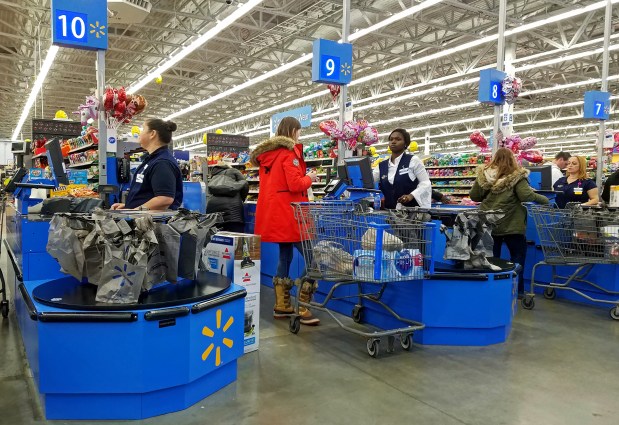Amazon vs Walmart: Who Will Bag the Victory in the Grocery Aisle?

Walmart, best known for offering products at wallet-friendly prices through its extensive network of physical stores, is setting records this month, driven by the success of its grocery offerings that continue to attract shoppers.
Meanwhile, Amazon isn’t satisfied with its penetration of the grocery sector and is extending its Amazon Fresh offering to non-Prime members.
Considering this, one can’t help but wonder if Amazon should concentrate on its expertise in eCommerce and let Walmart take charge of physical retail, especially since it’s doing anything but struggling in the realm of online commerce. Hear us out.
On Thursday (Nov. 9), PYMNTS reported that Amazon is extending grocery delivery and free pickup services to all customers in any U.S. city or town where its Amazon Fresh grocery stores are accessible to Prime members. The service, previously exclusive to Prime members, simplifies the process for all customers to buy groceries, both in-store and online, according to Amazon’s statement.
Also Thursday, Amazon announced that customers can now receive deliveries from various local grocery and specialty retailers listed on Amazon.com, such as Bristol Farms, Cardenas Markets, Pet Food Express, Weis Markets, and Save Mart.
The company intends to extend its grocery delivery and complimentary pickup services to non-Prime members, integrating Whole Foods Market pickups and delivery. This choice is influenced by the widespread adoption of the buy online, pickup in-store (BOPIS) method in the United States, as highlighted in “The 2023 Global Digital Shopping Index” by PYMNTS Intelligence and Cybersource. Among the six countries examined, the U.S. experienced the most substantial growth in BOPIS usage from 2021 to 2022. Furthermore, the U.S. maintains its leading position with the highest percentage of consumers opting for BOPIS to collect their latest eCommerce purchases, rising from 23% in 2021 to 32% in 2022.
In addition, the announcement comes a little over a month after Amazon disclosed its decision to lower the threshold for free grocery delivery for Prime members to $100 from $150, a minimum implemented earlier this year — from the company’s previous $35 threshold.
This decision aligns with findings from a PYMNTS Intelligence study on consumer shopping habits. The study indicates a decline in the number of shoppers predominantly making grocery purchases at physical stores, dropping from 63% in early 2020 to 44%. A growing segment, especially among millennials and bridge millennials, exclusively buys their groceries online.
Amazon has also shuttered its physical clothing stores in Glendale, California, and Columbus, Ohio, redirecting its attention to improving its online fashion shopping experience and growing its grocery stores business.
In the third quarter, revenue from Amazon’s physical stores segment, mainly from Whole Foods Market locations, rose by 5.6% to $4.9 billion, according to the report.
“If you really want to serve as much of grocery as we’d like to, you have to have a mass physical offering, and that’s what we’ve been working on for a few years with the brand we’ve called Amazon Fresh. We wish we were further along at this point. We’ve tried lots of ideas. We haven’t yet found conviction around the format that we want to expand much more broadly,” Amazon CEO Andy Jassy said in April, discussing the company’s other brick-and-mortar offering, the Amazon Fresh grocery stores.
Unpacking Walmart’s Grocery Game
Meanwhile, one key factor driving Walmart’s success is its dominance in the grocery sector. As the largest grocer in the nation, Walmart generates over half of its annual revenue from groceries. This category maintains its importance for shoppers, even during economic downturns or periods of inflation. In contrast to competitors like Target, which has faced challenges, Walmart has maintained strong sales and drawn foot traffic through its grocery offerings.
Walmart has capitalized on the opportunity presented by persistent inflation, especially in food and household essentials, to attract new or infrequent shoppers. The company has effectively drawn in more grocery shoppers from higher-income households, including those with incomes exceeding $100,000, to visit its stores and website.
To keep up with rivals like Target and Amazon, Walmart has reportedly prioritized enhancing the customer experience. The company has launched clothing brands, revamped its website and app, and will invest over $9 billion to upgrade its stores nationwide. Additionally, Walmart has expanded its online offerings by adding more items and brands through its third-party marketplace.
In fact, according to Denise Incandela, executive vice president of apparel and private brands at Walmart, the retailer aims to provide a high-end aesthetic without high-end price tags with its latest apparel offerings.
Read more: Walmart Apparel EVP: We Can Make Luxury Fashion Affordable

